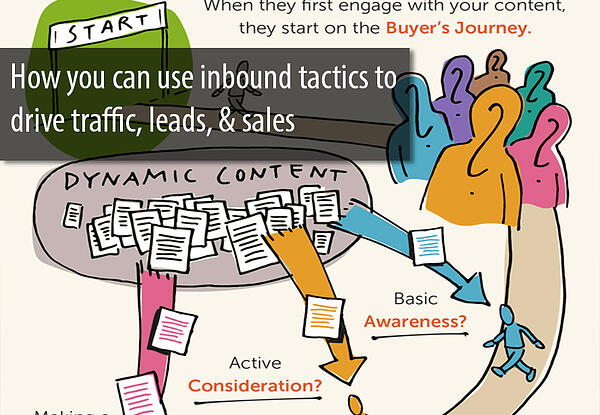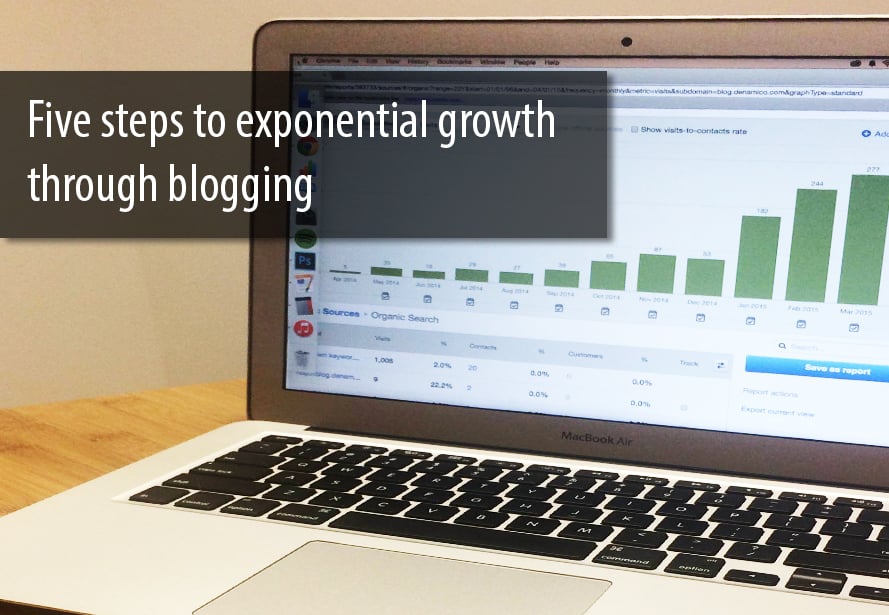
Why Inbound:
If you've read our blog in the past, you know we are strong believers in the power of Inbound Marketing. We've found that it is hands-down the best way to boost your traffic, leads and sales, which is why we decided to go down this path ourselves.
Leveraging technology, by turning your website into a lead generation machine, is one of the most important goals in scaling a business. But your website is only as good as the amount and relevance of traffic that arrives there. If you're looking for a smart way to influence the quantity of traffic and the quality of leads, inbound marketing might well be your answer. Read on to learn how it works.
How does it work?
This infographic from Emyth is helpful in visualizing how inbound marketing works to generate quality leads for your business.
Below the image, we expand on the important points so keep reading...
Closed Loop Marketing
In the pre-digital world, it was difficult for marketing to "close the loop" on its activities because it usually didn't know what happened to the leads it generated after they were forwarded to sales.
With digital however, everything is trackable, and the reporting available makes closing the loop much easier. When sales reports back to marketing on what happened to the leads, and each lead and customer can be traced back to a specific initiative, marketing can continually improve its success rate in delivering qualified leads.
Buyer Personas
Creating buyer personas is our starting point. We want to define our ideal customer by compiling all the data and insights we have about them.
Once we understand who we want to be talking to, we can figure out what challenges those people have and what makes them tick, which will help us to create content that interests them and helps make their lives easier.
Dynamic Content
One of the beauties of this type of marketing is that the awesome content we create is evergreeen. Unlike money spent on adwords or other advertising, which is gone the moment after the ad is finished, good content will continue to generate leads for us indefinitely and consequently delivers a great ROI.
It still requires investment to produce quality content that is worthy of your readers' time, but it pays off. Often even for years afterwards.
Buyer Journey
The time and actions your prospective customer takes between thinking about your service or product and actually buying it, is referred to as the buyer's journey. Most reports say that B2B buyers in today's world are 70% of the way through the buyer's journey before they ever contact a salesperson.
During that first 70% of their journey, they are speaking to friends and colleagues, and researching online for solutions to their problem. If you are one of the companies helping them better understand their problem so they can make a more educated, sound decision in resolving it, congratulations! You have already established credibility and trustworthiness in their eyes, and you will most-likely be on their shortlist of vendors.
If you haven't been helping them through this research process, because they never contacted you directly, then chances are they never will.
Offer
Once we've attracted our target customer to our site, we want to offer them a juicy carrot, so they will tell us a bit about themselves.
The offer could be an eBook, a whitepaper, access to a video or podcast, or maybe some sort of online tool that helps them do their job. We might start by asking for their email address and their role in their company. The better the offer, and the more they feel they need it, the more information we can ask them for in exchange.
Call To Action (CTA)
The call-to-action, or CTA, refers to the button we want our visitor to click on in order to obtain the offer (and give us their email address). In order for our offers to convert, we need to tell the visitor what action we want them to take.
Marketing Qualified Lead (MQL)
If our visitor obliges us and clicks on our CTA, we're all happy. They get access to some useful content and we have a new lead interested in our product or service. This person moves from being a prospect to being a Marketing Qualified Lead.
An MQL is more likely to become a customer in the future because they have taken a step (clicked on the CTA and downloaded our offer) indicating they are interested in what we have to say.
If the person has downloaded multiple offers, we can use a lead scoring system to indicate the priority in which sales would want to follow up with them in comparison with other MQLs. When they have downloaded more than one offer, we know they're either more interested, or their problems/challenges need a more urgent solution, and they are more likely to become a customer sooner.
Lead Nurturing
Lead nurturing, also known as 'drip marketing', is another key component of inbound marketing. We all know from personal experience that we might research something for weeks or months, maybe even years, before we decide to buy. If our prospect has downloaded an eBook, perhaps advising them on the top 5 things to be aware of before purchasing our product or service, we know we have an MQL with an email address.
Now that we know what this lead is interested in, we can continue to email them with other relevant content offers, which could continue to help them along their buyer journey. The key with lead nurturing is that the content we send them needs to be RELEVANT. If it's not, we're going to completely annoy our lead and they will very quickly unsubscribe and all our good work and efforts will have gone by the wayside. Not only that, once we've annoyed someone, or even worse, if they think we've done the "S" word (spammed them), it is very difficult to earn their trust back.
Lead nurturing can be a lot of work if you do it manually, especially trying to make the content relevant for each lead. But if you're using marketing automation software, it can all be done automatically once you've set up workflows. That's right, a lead generation machine working 24/7 while you sleep. Who wants to sign up for one of those?
Sales Qualified Lead (SQL)
Sales leads, or Sales Qualified Leads (SQLs), are those leads that marketing and sales have jointly identified in advance as worthy of a sales follow-up. Usually it's because they've downloaded one of your bottom-of-funnel offers, meaning they are closer to making a decision compared with someone who is still in the early part of their buyer journey and is interested mainly in top-of-funnel offers.
Marketing and sales might also decide that anyone who downloads at least 4 offers for example, is also considered an SQL. In most cases, this is something that is continually evaluated and revised because as you're creating more content and doing your closed-loop-reporting, you might see connections that numerous customers have in common. Maybe there is one offer which was intended to be middle-of-funnel, but in fact over 50% of the leads who have downloaded it have gone on to become customers. If so, just downloading that one specific offer might make a lead an SQL.
CONCLUSION:
Once you understand how it all works, it is difficult to find a reason to not do inbound marketing. Not only does it work in attracting qualified leads and shortening the sales cycle, but it has been proven to give the best ROI compared with other marketing alternatives.
If you're in the Twin Cities and would like to learn more about Inbound marketing and how it can boost traffic, leads, and sales for your business, join us on Wednesday, March 4th. We're hosting a seminar in conjunction with Global Inbound Marketing Week. You can find all the details here.
Share this
You May Also Like
These Related Stories

5 Steps to Creating a Successful Inbound Marketing Blueprint
10 Key Lead Generation Terms



/Accreditations/CRM-Implementation-Accredited-Badges.png?width=170&height=138&name=CRM-Implementation-Accredited-Badges.png)
/Accreditations/Onboarding-Accredited-Badges.png?width=170&height=137&name=Onboarding-Accredited-Badges.png)
/Accreditations/Custom-Integration-Accredited-Badges.png?width=170&height=137&name=Custom-Integration-Accredited-Badges.png)

